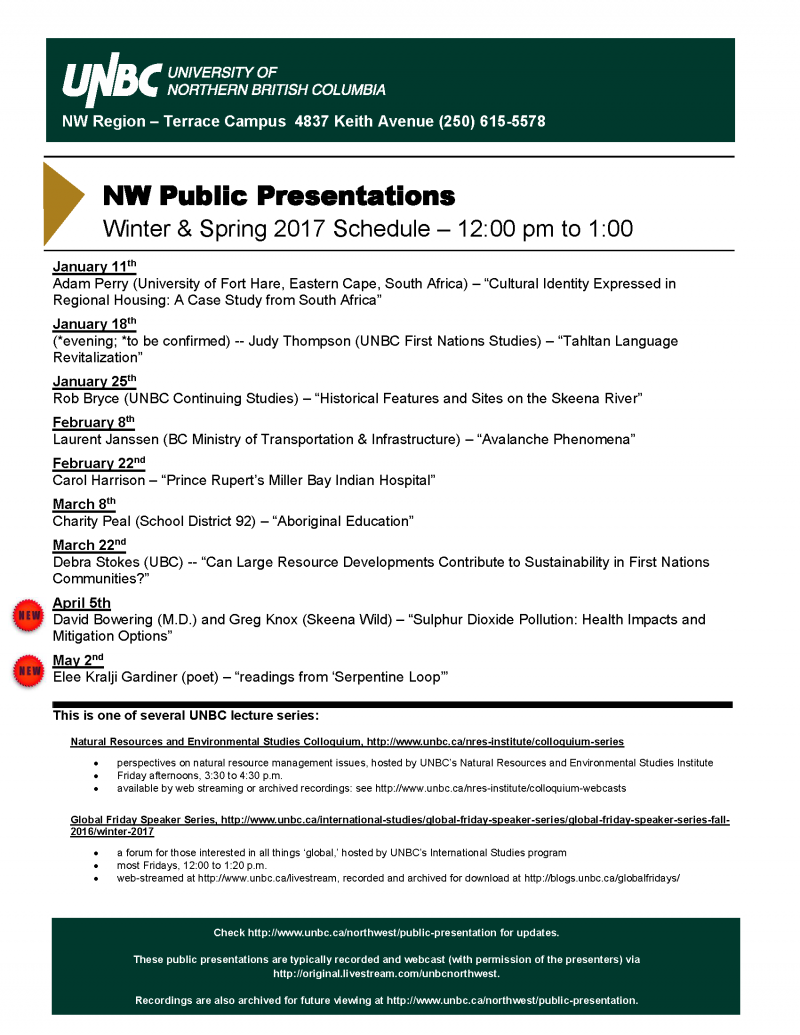Public Presentation Winter 2017 - Lineup
December 20, 2016

UNBC Northwest Public Presentation
UNBC Northwest is pleased to announce the Winter 2017 Public Presentations Lineup! These events are free and open to the public; you are welcome to bring your lunch. Some events may be webcast and/or recorded, with permission of the speaker.
Location: UNBC Terrace Campus (4837 Keith Avenue), Room 103/104
Time: 12:00 – 1:00 PM
Streamed live (if permitted by the presenter) via the UNBC NW Livestream Channel on the dates listed below.
Event Archives
- January 11, 2017: Adam Perry - “Cultural Identity Expressed in Regional Housing: A Case Study from South Africa”
Constructing similarly styled (vernacular) houses can offer members of a community a supportive reminder to the reasons why architectural features persist and remain practical. In a context of the Eastern Cape, South Africa, settlements are constructed in a manner in which their duration moderates expression for gathering, cooperation, ritual and culture. I describe the material culture of homes among residents who identify as Xhosa. I infer that forms of regional housing reflect forms of resistance to structural inequity in a changing South African society. - January 18, 2017: Judy Thompson - “Tahltan Language Revitalization”
In August 2012, Edōsdi defended her doctoral dissertation, Hedekeyeh Hots’ih Kāhidi – “Our Ancestors Are In Us”: Strengthening Our Voices Through Language Revitalization From A Tahltan Worldview. Her dissertation employed a Tahltan research paradigm and spoke to the ways in which the voices of her people can gain strength and healing through the revitalization of their Tahltan language. Upon the completion of her doctoral degree, Edōsdi was hired by the Tahltan Nation to take on the position of Tahltan Language and Culture Lead. Her doctoral research guided the development of a language governance structure and a language revitalization plan, which focuses on programming, documentation, and training and professional development. This 64-min documentary, Dah Dẕahge Nodes̱idē - “We Are Speaking Our Language Again”, focuses on the language revitalization work that the Tahltan Nation has been carrying out since 2012. - January 25, 2017: Rob Bryce – “A Visual Skeena River Historic Journey!”
Much of the history of Northwest BC from Hazelton to Prince Rupert is focused along the banks of the Skeena River. This visual presentation will highlight the many features along this corridor and focus on those which still remain today and why they are significant. - February 8, 2017: Laurent Janssen - "Digging into the Avalanche Phenomenon"
Learn the basics of avalanche phenomena. Appreciate the complexity of avalanche forecasting! We will explore the life cycle of a snowflake. - February 22, 2017: Carol Harrison - "Miller Bay Indian Hospital"
Miller Bay Hospital, just a few miles from Prince Rupert, was one of a string of "Indian" hospitals across Canada, initially opened for the treatment of tuberculosis patients from the indigenous population. It opened in 1946 and did not completely close until 1971. During those years many people spent their childhoods or young adulthoods there as patients; countless others worked there in all capacities, from dishwashers to medical directors. Miller Bay is now in ruins, largely overgrown and disappearing into the landscape, but its legacy remains and should not be forgotten. - March 8, 2017: Charity Peal - "Aboriginal Education"
Aboriginal education has always been . . . it has always existed. First Nations students live and walk in many worlds. My educational experiences have allowed me to know and learn alongside many different and diverse people. What is Aboriginal Education? - March 22, 2017: Debra Stokes - "Can Large Resource Developments Contribute to Sustainability in First Nations Communities?”
Several liquefied natural gas (LNG) terminal projects have been proposed in northwest B.C. These large developments are similar to mining developments in resource-dependent towns, where communities experience boom and bust dynamics associated with both benefits and impacts occurring during different project phases. Indigenous peoples are particularly vulnerable to large resource-development projects, as many are in poverty and their education and employment rates are lower than non-indigenous populations. The purpose of this study is to investigate how benefits from large resource developments can be enhanced so that indigenous communities can sustainably develop and improve their overall standard of living.- YouTube Archive Currently Unavailable
- If you would like to notified when the video is available, please e-mail Alexander Ippel.
- YouTube Archive Currently Unavailable
- April 5, 2017: David Bowering & Greg Knox - “Sulphur Dioxide Pollution: Health Impacts and Mitigation Options”
We will critically review the process leading to Rio Tinto being permitted to significantly increase SO2 emissions from its Kitimat smelter and ask whether the process adequately protects the health of people in the Kitimat/Terrace airshed.
We will then review the technical options for reducing sulphur dioxide emissions. Detailed options were researched by Rio Tinto prior to receiving a permit to increase SO2 levels from 27 to 42 tonnes per day. Drawing on Rio Tinto’s own expertise, the literature, and examples of other smelters, the viability of different technologies to reduce pollution will be reviewed, including their effectiveness, environmental impacts, and costs. - May 2, 2017: Elee Kraljii Gardiner - “Readings from ‘Serpentine Loop’”
Writers, like skaters, score the blank sheet and test the edge of inclusion and exclusion. Most of these poems begin with a word from skating and push off to another topic. Others revisit ideas of femininity, control, and language as pattern, or visit the past through movement, or enact principles from the rink such as symmetry, joy, endurance, crescendo and accent, revolution, response.
The blade melts ice via friction and pressure. Even though the author drifted away from skating, the language was imprinted in her -- a tracing, a line extending beyond the margins.
These are engaging and poignant poems about life on and off the ice.
